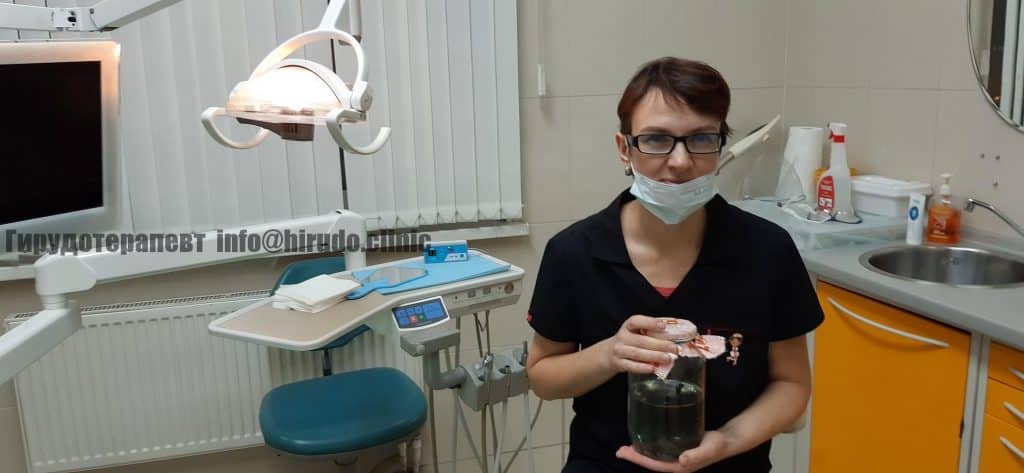Leech therapy in dentistry has many advantages. Leeches drain inflammation at the site of the abscess. Anticoagulants in leech saliva increase blood flow in the gums. In addition, they remove toxins and enhance nutrition of the affected area. Additionally, the antibacterial components of leech saliva reduce the growth of bacteria. Hirudotherapy is also successfully used in root canal treatment.
hirudotherapy in dentistry
Leech therapy in dentistry is used in a number of countries as an alternative treatment method.
Leeches secrete various biologically active substances that have a positive effect on the body. Let's figure out how it works step by step:
- Attaching a leech: When the procedure begins, a leech is attached to the affected area. It begins to actively absorb blood, which helps drain inflammatory fluids and reduce swelling.
- Blood sucking: During the absorption process, the leech can remove a small amount of abscess or inflammatory fluid.
- Saliva secretion: During the absorption process, the leech secretes its saliva, which contains various biologically active substances. One of the components is anticoagulants, which prevent blood clotting and improve local blood circulation.
- Increased blood flow: Due to anticoagulants and the massage effect of the leech, blood flow in the affected area improves. This promotes rapid healing and improves the supply of oxygen and nutrients to the tissues.
- Antibacterial action: Leech saliva contains antibacterial substances that help reduce the growth and activity of harmful bacteria in the affected area.
- End of session: After the leech gets enough, it will fall off on its own. The area where the leech was attached may bleed a little due to the anticoagulant effect, but this usually goes away quickly.
Application in root canal treatment:
Hirudotherapy can help reduce inflammation and soreness after root canal procedures.
Detoxification:
Leeches help remove toxins from the affected area.
It is important to remember that leech therapy is a complementary treatment and should only be performed by qualified professionals under sterile conditions. Not all patients are suitable for this procedure, so consultation with a specialist is necessary before starting treatment.
Treatment with leeches dentistry: historical cases of use for treatment
In 1817, Thomas Bell used leeches to treat oroantral fistula and facial edema. He applied six leeches, which were applied to the patient's face. In 1839, Chapin A. Harris used leeches to drain a gum abscess. He used special tubes to attach the leeches to the gums. Another famous case of the use of leeches in medicine was described in 1854 by Spencer Bate. He used a leech to treat a large, carious maxillary central incisor by attaching it to the patient's gum.
Many reports mention the use of leech for dental abnormalities. Traumatic and postoperative macroglossia (swelling of the tongue) is associated with life-threatening complications, especially airway obstruction.
Phlebotomy with leeches has been reported to be a significant success in treating severe postoperative cases of macroglossia when conventional treatment has been unsatisfactory. Other reports describe the use of medicinal leech in the treatment of sublingual hematoma and massive lingual hematoma. Also, leech therapy in dentistry helps with gum diseases. For example, direct application of 3-4 leeches can be a successful remedy for abscess and gum inflammation.
In general, leech therapy has been used for a variety of medical conditions since the early 19th century, including the treatment of oroantral fistula, facial swelling, gum abscesses, and dental caries. Leeches were attached to the affected area using special tubes or directly to the gum.
Medicinal leeches have been used in the treatment of many childhood diseases & suspected symptoms caused by teething. There are reports in the literature about the benefits of using leeches for dental anomalies. Leech bleeding has been used as an adjuvant in the treatment of severe postoperative macroglossia, in addition to the conventional treatment method.
There have been reports of leech use in the treatment of sublingual hematoma and massive lingual hematoma, gum disease, and as a remedy for abscess and inflammation.
Leech therapy, medical treatment, historical cases, facial swelling, abscess drainage, dental caries, attachment methods, special tubes, direct application, Thomas Bell, Chapin A. Harris, Spencer Beitom.
The concept of “detoxifying” using leeches is often mentioned in the context of hirudotherapy, but it is important to understand that this statement requires more detailed consideration.
- What are "toxins"? In the context of medical use of the term, "toxins" usually refer to certain harmful or poisonous substances. However, in alternative medicine, the term "toxins" may have a broader and less specific definition. The term is often used to describe any "harmful" substance in the body.
- Lysing of microorganisms: It is believed that leeches contribute to the lysis (destruction) of certain microorganisms in the bite area. This may help reduce the number of bacteria or other pathogens at the site of inflammation.
- Stimulation of blood circulation: As mentioned earlier, leech saliva contains anticoagulants that prevent blood clotting. This may help improve blood circulation in the bite area. In turn, it can help in “cleansing” this area of harmful substances.
- Secretion of bioactive substances: Leech saliva contains many different bioactive substances. They may have antioxidant, anti-inflammatory and other beneficial effects. This helps to “cleanse” the affected area.
However, it is important to emphasize that while hirudotherapy may be beneficial in some cases, the claim of “detoxification” should be viewed with caution. Scientific research in this area may be limited, and what exactly is meant by “toxins” is not always clearly defined.
